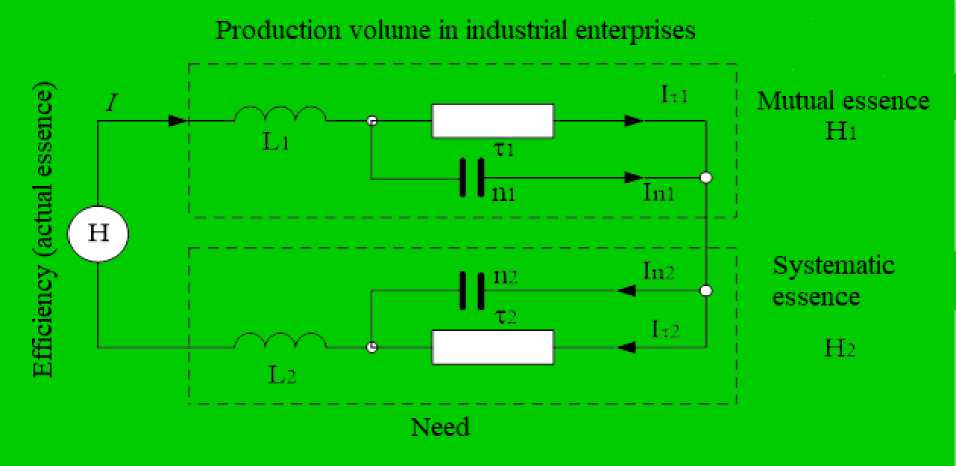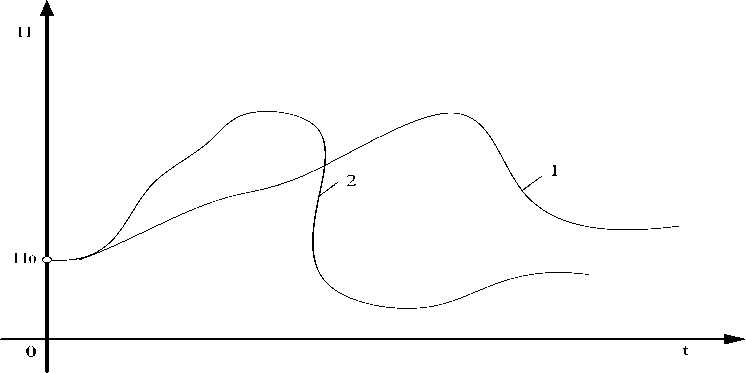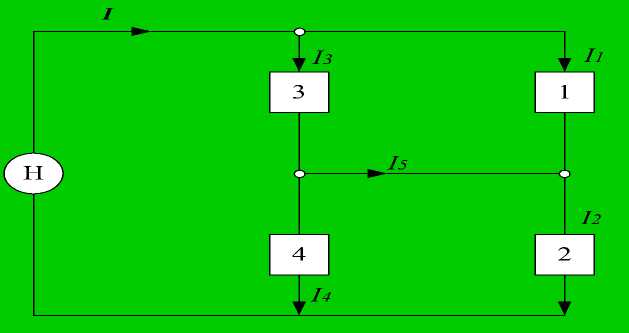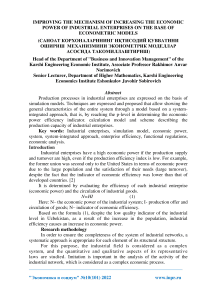Improving the mechanism of increasing the economic power of industrial enterprises on the base of econometric models
Автор: Rakhimov A.N., Eshonkulov J.S.
Журнал: Экономика и социум @ekonomika-socium
Рубрика: Основной раздел
Статья в выпуске: 10-1 (101), 2022 года.
Бесплатный доступ
Production processes in industrial enterprises are expressed on the basis of simulation models. Techniques are expressed and proposed that allow showing the general characteristics of the entire system through a model based on a system-integrated approach, that is, by reaching the p-level in determining the economic power efficiency indicator. calculation model and scheme describing the production capacity of industrial enterprises.
Industrial enterprises, simulation model, economic power, system, system-integrated approach, enterprise efficiency, functional regulations, economic analysis
Короткий адрес: https://sciup.org/140300222
IDR: 140300222
Текст научной статьи Improving the mechanism of increasing the economic power of industrial enterprises on the base of econometric models
Industrial enterprises have a high economic power if the production supply and turnover are high, even if the production efficiency index is low. For example, the former union was second only to the United States in terms of economic power due to the large population and the satisfaction of their needs (large turnover), despite the fact that the indicator of economic efficiency was lower than that of developed countries. [2]
It is determined by evaluating the efficiency of each industrial enterprise (economic power) and the circulation of industrial goods.
N=HI (1)
Here: N– the economic power of the industrial system; I- production offer and circulation of goods; N– indicator of economic efficiency.
Based on the formula (1), despite the low quality indicator of the industrial level in Uzbekistan, as a result of the increase in the population, industrial efficiency causes an increase in economic power.
Research methodology
In order to ensure the completeness of the system of industrial networks, a systematic approach is appropriate for each element of its structural structure.
For this purpose, the industrial field is considered as a complex system, and the quantitative and qualitative aspects of its representative laws are studied. Imitation is important in the analysis of the activity of the industrial network, which is considered as a complex economic process.
Analysis of literature on the topic
In this case, the essence of the process being studied is expressed through signs, used indicators, endogenous and exogenous parameters. Then, based on economic laws, the necessary simulation equations are derived. It is possible to obtain results by changing the control parameters. These equations are a simulation model of the studied economic process, phenomena.
A.A.Denisov emphasizes the evaluation of the efficiency of each industrial enterprise (economic power) and determination through the circulation of industrial goods.[2]
B.Berkinov and H.S.Mukhitdinov say that through the development of industrial sectors, simulation indicators and systematic modeling methods of management are useful for creating an automated information base in modeling the development of social processes in the regions, increasing the standard of living of the population. [1]
At the same time, it should be recognized that there are a number of advantages inherent in the simulation modeling system. The main of them are: ease of learning, relatively low costs associated with model development, reliability of the compiler, automation of collection, processing and presentation of modeling results, the ability to connect to modules written in universal programming languages, and ease of programming.
At the same time, scientists Yu.S.Kharin, V.I.Malyugin and V.P.Kirlitsa recognized that this system has its own shortcomings. In particular, its lack of flexibility, the fact that it can be applied to the development of models belonging to a certain category of statistical modeling, are justified. [3]
N. Makhmudov stated that it is appropriate to use systematic integrated simulation models in the assessment and forecasting of each industry branch, taking into account the main influencing factors of economic indicators in the industry. [4]
Because in system-integrated simulation modeling, complex processes are first experienced and simulated in EHM. On this basis, management decisions are made and the economic capacity of production in industrial enterprises is analyzed, synthesized and forecasted.
These models constantly feel the forces of motion relative to themselves. This, first of all, makes it possible to analyze issues related to the state of internal flexibility of the system.
Analysis and results
In the verification of the efficiency of the economic power of industrial enterprises, both vertical (between individual elements of the system management) and horizontal (in each product life cycle) are carried out through an integrated approach. A model based on a systemic-integrated approach makes it possible to show the general characteristics of the entire system.
^^) = Xkd(t) - Xkx(t) (2)
Xkd(t) = Xkd^t) + Xkd2(t) +— + Xkdn(t) - total income per population from n types of industry;
Xkx(t) = Xkx 1 (t) + Xkx2(t) + — + Xkxn(t) - total expenditure per population on n types of industry.
As we can see, the presence of integrative properties is characteristic of the system, which is present in the system, but is not characteristic of any of its individual elements, or consists of their sum.
The task of this model is to calculate the efficiency of the entire system of industrial sectors, not the sub-system. It follows that it is appropriate to use this model for each industry.
Naturally, our goal is to calculate the economic power in the systematic analysis by reaching the p-level in determining the H-efficiency indicator. We can define this as the following base two logarithm efficiency [2]:
// = -l0g2(1-p) (3)
Here: H is the natural efficiency indicator of meeting needs in the industrial network (utility character of the object); r-level of satisfaction of the need for industrial products; (1-p)–probability of not achieving the goal.
As we can see from the formula (3), the level of satisfaction of the population's need for industrial products increases depending on how high the level of economic efficiency is.
If the need is fully satisfied, p=1 (which, of course, will never be fully satisfied), the efficiency will be infinite H 0 =∞. If the need is half satisfied, i.e. p=0.5, then efficiency will be N 0 =1. If the population need p=0 is not satisfied, the level of efficiency N 0 =0 will be zero.
In the global economy, there is a market for goods, capital, and labor as well as for services. This market consists of a complex system, the main task of which is to satisfy the needs of the population for services. The real sector market is based on the industrial sector of the wide and rapidly developing world economy. In the world economy, industrial enterprises serve as the main factor in increasing the level and quality of life.

Figure 2. Scheme describing production capacity in industrial enterprises.1
Thus, the higher the N efficiency, the greater the need. Therefore, the level of economic efficiency of industrial enterprises is a stimulating force in increasing the quality indicator. We can see this in Figure 2.
Here: H– efficiency indicator (the power that activates the economic process); N 1 – mutual essence (results from production costs); N 2 – economic systemic essence (the final value of the service or industry after excluding costs for the consumer. For example, if the service offer or industry is free, the cost incurred for the industry N 2 is the same as the efficiency indicator N). In other words, if the industry is free, then the value of demand N 2 corresponds to the efficiency N of the entire industry level.
If the need for industry is met from one region to another, it will look like this:
H — H 1 + H 2 (4a)
ёки
P 0 —P 1 +P 2 - P 1 P 2 (4b)
Here: r0 is the a priori (internal) level of need satisfaction; r 1 – mutual level of need satisfaction; r2 - the real level of satisfaction of the need. In this case p 1 < P o , P 2 < P o . [5]
T 1 and t2 - Producers of industrial products and resistance to their movement, it is necessary to take into account obstacles that may be encountered in meeting the needs for industrial products.
n 1 ва n2 - Саноат корхоналарининг ишлаб чикариш имкониятлари ( J нормал захира шароитида).
n 1 and n2- production capabilities of industrial enterprises (J under normal reserve conditions).
L 1 and L2 - Creates regulatory standards that regulate any changes in the need for industrial products.
We express the equation of the process shown in Figure 2 in the following form. [2]
H^ — L^dI/dt + ItiTi; ^ti^i — 1 Inidt;
n1 J
H 2
I — Ini
— L2dl/dt + It2t2; It2t2 ——[ I^dt’
n2 J
+ IT1 — In2 + I t2> (5)
In this case, industrial enterprises are considered as a general solid system, and its (procedure) stages are as follows:
to study the possibility of industrial production, to analyze its components, to reveal the interrelationships between individual elements;
collecting information about the working mechanism of the industrial system, researching information flows, observing and experimenting with the analyzed system, and developing models;
-
checking the adequacy of models, analyzing uncertainty and sensitivity;
ресурс имкониятларини тадқиқ этиш;
determining the goals of systematic analysis in industrial mines;
formulation of criteria;
developing alternatives;
making choices and making decisions;
implementation of analysis results.
Now if we calculate the economic capacity or efficiency of production of industrial enterprises, we will certainly see that there is a difference between the types of industrial sector. Биз буни H { ва H деб белгилаб олсак унинг йиғиндиси қуйидаги кўринишга эга бўлади:
If we define it as H [ and H its sum will look like this:
H = H ' + H ' as well as H2 = H 2 + H2 It is based on the assessment of the needs for the types of industrial products and the volume of production.
H2' = H
For this purpose, funds are spent on industrial enterprises in order to develop the volume of production of industrial products.
The analysis for the purpose of perfecting the management system of any industrial enterprises also depends on a set of important regulations. Functional regulations include speed and quality of processing plans, accurate organization of subdivisions, operational calculation and control, strict distribution of functional responsibilities in each subdivision of the structure.

Figure 3. Supply (1) and consumption (2) line of industrial enterprises.2
The higher the income from the production of industrial enterprises, the more they try to increase the average production of industrial products. In embedded mode H 1 = H2 = H/2. In this case 1 1 =1 2 =^ , if the average normal time of industrial enterprises is not equal to the average production time of product demand H2 Ф H 1 , the volume of industrial products exceeds the demand or cannot supply enough products (Fig. 3), in a short time (1) the supply of industrial enterprises increases, (2) the volume of demand for industrial products decreases. [6]
-
2 Development of authors.
Therefore, it is necessary to equalize the balance of the balancing period of the industrial level (Fig. 3).
Also, if in the 1st block the industrial product is converted into money, in the 2nd block the money is converted into an export of the industrial product, then in the 3rd block the industrial product is converted into money, and the 4th block is converted into payments of the industrial product in monetary value (Fig. 4).

Figure 4. Scheme of transformation of industrial products into money, money into products.
Саноат корхоналарида ишлаб чиқариш мувозанатлаштирилганда I 3 =I 4 бўлади, ишлаб чиқариш ҳажми етарли даражада бўлмаганда ишлаб топилмаган пул оқими I 5 -истеъмолчига кетади, саноат маҳсулотлари ҳажми ортиб кетганда солиқ тизимига оқади, саноат корхоналарининг даромади I 4 I 3 сарфидан ошади.
When the production in industrial enterprises is balanced, I 3 =I 4 , when the volume of production is insufficient, the unearned money flow goes to the I 5 -consumer, when the volume of industrial products increases, it flows into the tax system, the income of industrial enterprises exceeds I 4 consumption of I 3 .
/ = /1 + /з =4 + 4; 4=4 + 4; /з=4 + /5. (6)
Even if the economy is balanced, i.e. T 1 T 4 = т2т3, the calculation of n and L will have /5 ^ 0, that is, if the sufficiency or insufficiency I 5 flows from left to ten, I 2 >I 1 (demand is greater than the volume of industrial products), the price of products will increase. If I 3 >I 4 , the budget expenditure is greater than the income, the budget deficit leads to an increase in the price of industrial products. If I 1 >I 2 , (the volume of industrial products is greater than consumption), prices will decrease. [7]
As we can see from Figure 4, as a result of the transition from finished products to money, from money to products (raw materials), a cycle of production is formed. During this period, a program for the development of industrial enterprises will be developed.
Conclusions and suggestions
In conclusion, it is necessary to develop plans for the development of industrial enterprises in the republic, regions, cities and districts, that is, to increase the volume of production and the quality of products, and to monitor the status of their implementation.
It is necessary to create complex measures of the management system of industrial enterprises, plan and control the activities of industrial enterprises.
Taking into account the needs of industrial enterprises, it is necessary to increase the volume of production using the budget funds in enterprises with low capabilities, to control its implementation and spending.
Population Services on the Basis of Imitation Models //Academic Journalof
Digital Economics and Stability. – 2021. – С. 51-57.
Population Services on the Basis of Imitation Models //Academic Journalof
Digital Economics and Stability. – 2021. – С. 51-57.
(дата обращения: 07.10.2022).
"Экономика и социум" №10(101) 2022
Список литературы Improving the mechanism of increasing the economic power of industrial enterprises on the base of econometric models
- Беркинов Б., Мухитдинов Х.С. Ахолини ижтимоий химоялашнинг ахборотлашган мулокат тизими. //Интеллектуализация систем управления и обработки информации: Тез. докл. Меж.нар.науч.конф.8-9 сентябр 1994. —Т.: 1994. 197 б.
- Денисов А.А. Современные проблемы системного анализа: учебник. Изд. 3-е, перераб. идополн. -СПб.: Изд-во Политехн. ун-та, 2009. - 304 с.
- Харин Ю.С., Малюгин В.И., Кирлица В.П. Основы имитационного и статистического моделирования. - Мн.: Дизайн ПРО, 1997, С. 181-182.
- Махмудов Н. Енгил саноат корхоналарининг иктисодий самарадорлиги асосида ахоли турмуш даражасини оширишнинг стратегик имкониятлари //Иктисодиёт ва таълим. -Тошкент, 2010.№2.-Б. 42.
- Эргашев Р.Х., Равшанов А.Д. «Пути стратегического развития и повышения конкурентоспособности сельскохозяйственных предприятий». Журнал NX, том. 7, нет. 1, 2021, с. 99-105.
- Эргашев, Р. Пути управления рыбными хозяйствами и развития производственной деятельности / Р. Эргашев, Ю. Беглаев // Международный журнал научно-технических исследований. - 2020. - Вып. 9. - № 2. - С. 919-921.
- Рахматулла Хидирович Эргашев, Зухра Джабборова Значение инновационной деятельности в туризме European Scholar Journal (ESJ) Доступно на сайте: https://www.scholarzest.com Vol. 2 Нет. 4, апрель 2021 г., ISSN: 2660-5562 https://scholarzest.com/index.php/esj/article/view/663/554
- А.Б. К., Н.М. Дж. Инвестиционные направления и принципы развития предпринимательской деятельности в регионах //Журнал современных проблем бизнеса и власти| Том. - 2021. - Т. 27. - нет. 2. - С. 4047.
- Курбанов А. Б., Джалилова Н. М. Роль малого бизнеса в национальной экономике // Американский междисциплинарный журнал
- Bobaqulovich, Ravshanov Alisher. "Problems of reflecting the cost of goods and material resources." ijodkor o'qituvchi 2.19 (2022): 151-159.
- Ikramovich, R. Z. Z., Shukhratovna, Y. S., To'lqinovich, S. B., & Ibragimovna, B. L. (2021). Monetary Policy Of The Uzbekistan And Its Improvement Ways In Implementing. Journal of Contemporary Issues in Business and Government, 27(1), 1551-1557.
- Rakhimov A. N. Econometric modeling of the development of educational services to the population of kashkadarya region //Academicia: an international multidisciplinary research journal. - 2021. - Т. 11. - №. 2. - С. 1305-1312.
- Baymamatovna, Taylakova Dilafruz. "The Importance of the Service Sector in Increasing the Living Standards of the Population." Academic Journal of Digital Economics and Stability (2021): 165-170.
- Bobokulovich K. A., Yulchiyena A. M. Prospects for the development of fruit and vegetable enterprises //JournalNX. - 2020. - Т. 6. - №. 12. - С. 1315. Norimovich R. A., Kuldoshovich B. J. Improving the Development of Population Services on the Basis of Imitation Models //Academic Journal of Digital Economics and Stability. - 2021. - С. 51-57.
- Norimovich R. A., Kuldoshovich B. J. Improving the Development of Population Services on the Basis of Imitation Models //Academic Journal of Digital Economics and Stability. - 2021. - С. 51-57.
- О.Дж.Хусаинов. Socio-economic characteristics of the development of the infrastructure system providing services to the livestock network in the conditions of innovative economy. "Экономика и социум" №12(79) 2020
- KHUSAINOV O. Ways of developing the livestock sector, taking into account the fodder base and infrastructure services // International Journal of Management, IT & Engineering. Published: Vol. 12 Issue 02 February 2022. USA, 82-89 pages. Journal Homepage: http://www.ijmra.us
- Бегимкулов Ф.Э., Шодиев Б.Т. Сочетание управленческих навыков преподавателя и инновационной деятельности в педагогическом процессе // Вестник науки. 2020. №12 (33). URL: https://cyberleninka.ru/article/n/sochetanie-upravlencheskih-navykov-prepodavatelya-i-innovatsionnoy-deyatelnosti-v-pedagogicheskom-protsesse (дата обращения: 07.10.2022).
- Файзиева Ш. Ш. Роль сельскохозяйственных агрокластеров в повышении экономической эффективности //Gospodarka i Innowacje. -2022. - Т. 22. - С. 465-470.
- Shodmonovna F. S. State Support is A Key to Increasing the Economic Efficiency of the Enterprise //International Journal on Economics, Finance and Sustainable Development. - 2022. - Т. 4. - №. 3. - С. 153-159.


